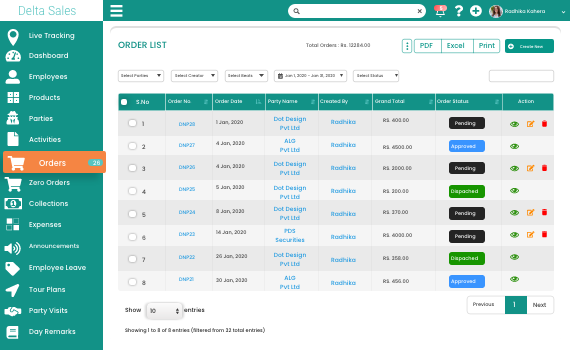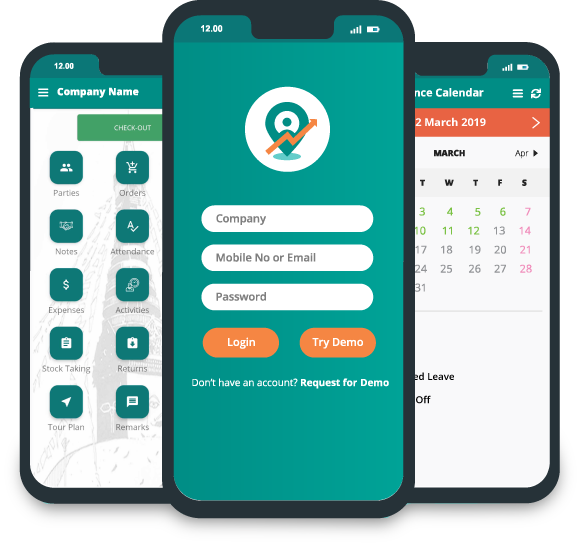From Order to Delivery: How Sales Order Management Apps Streamline Your Entire Sales Cycle

In today’s highly competitive business landscape, efficiency is more than a goal, it’s a necessity. From manufacturers to distributors and wholesalers, every business wants to deliver products to customers faster, with fewer errors, and higher satisfaction. Yet, traditional sales processes, with manual order tracking, paper-based documentation, and disconnected systems, often slow operations and create gaps in communication.
This is where a sales order management app comes into play. By automating and centralizing the entire sales process, these apps help businesses manage orders efficiently, track deliveries in real-time, and ultimately provide a seamless experience for both employees and customers. In this blog, we will explore how a sales order management app streamlines every stage of the sales cycle from order placement to delivery and why it has become indispensable for modern businesses.
Understanding Sales Order Management
Sales order management is the process of tracking, managing, and fulfilling customer orders. Traditionally, this involved multiple departments working in silos, sales teams taking orders, finance teams handling invoices, warehouses preparing shipments, and logistics coordinating deliveries. This fragmentation often resulted in errors, delays, and poor customer experience.
A sales order management app centralizes all these activities, providing a single platform to:
Record and process customer orders efficiently
Check inventory availability in real-time
Generate invoices automatically
Track the order fulfillment process
Monitor delivery and customer satisfaction
By connecting every step in one system, businesses gain end-to-end visibility and control over their sales cycle.
Why Businesses Need a Sales Order Management App

Here are the key reasons a sales order management app has become a must-have for businesses aiming to scale:
1. Reducing Manual Errors
Manual order processing is prone to mistakes, wrong quantities, missed orders, or incorrect delivery addresses. Each error not only costs time but can also damage customer trust. A sales order management app automates data entry, validates order details, and ensures that the right information flows across all departments.
2. Faster Order Processing
Time is money, especially in sales. Manual processes slow down order confirmation and fulfillment. With a sales order management app, orders can be processed instantly. Automated workflows ensure that as soon as a sales order is placed, it triggers notifications to inventory, finance, and logistics teams, significantly reducing lead times.
3. Real-Time Inventory Management
One of the biggest challenges in sales order fulfillment is knowing whether the products are in stock. A sales order management app integrates with your inventory system, providing real-time stock updates. This prevents situations where orders are accepted for out-of-stock items, improving accuracy and customer satisfaction.
4. Seamless Communication Across Teams
A disconnected sales process often creates communication gaps between sales, warehouse, finance, and delivery teams. A sales order management app provides a unified platform where all teams can collaborate. Everyone has access to the same data, reducing delays and misunderstandings.
5. Enhanced Customer Experience
In today’s market, customers expect transparency. They want to know if their order is confirmed, when it will be shipped, and how to track it. With a sales order management app, businesses can provide automated updates to customers at each stage of the order cycle, enhancing trust and satisfaction.
How a Sales Order Management App Streamlines the Sales Cycle
A sales order management app impacts every stage of the sales cycle. Let’s break down how it works from order placement to delivery:
Step 1: Order Placement
The sales process begins when a customer places an order. Whether through an e-commerce platform, a sales representative, or a phone call, the order details are captured directly in the app. Key benefits include:
Instant validation of order details
Automatic pricing, discounts, and tax calculations
Real-time inventory checks to confirm availability
This ensures that only feasible orders move forward, reducing cancellations and backorders.
Step 2: Order Approval and Processing
Once an order is placed, it needs approval from sales or finance teams depending on the business workflow. A sales order management app automates approvals by setting predefined rules for instance, high-value orders may require manager approval, while regular orders proceed automatically.
Processing becomes faster as the app generates invoices, updates inventory, and sends order confirmations to both the customer and internal teams.
Step 3: Inventory Allocation and Warehouse Management
After approval, the warehouse team prepares the items for shipment. The app ensures accurate allocation of stock and reduces the risk of over-committing inventory. Features like batch tracking and expiration management are especially useful for businesses handling perishable goods or serialized products.
Warehouse staff can also update the order status in real-time, providing full visibility to sales and delivery teams.
Step 4: Shipping and Delivery Tracking
Delivery is the final and often the most visible stage of the sales cycle. A sales order management app can integrate with logistics partners to track shipments in real-time. Customers receive notifications on order status, estimated delivery times, and any delays, enhancing transparency.
Moreover, if a delivery issue arises, the app allows teams to react promptly, rerouting shipments or managing returns efficiently.
Step 5: Post-Delivery Reporting and Analytics
A sales order management app doesn’t just help with operational efficiency, it also provides valuable insights. Businesses can analyze:
Sales trends by product, region, or salesperson
Order fulfillment timelines and bottlenecks
Customer satisfaction metrics
Inventory turnover and demand forecasting
This data empowers management to make informed decisions, optimize the supply chain, and drive better sales strategies.
Benefits Beyond Efficiency
Implementing a sales order management app goes beyond operational efficiency. It creates lasting advantages that impact costs, growth, compliance, teamwork, and customer relationships. Here’s what businesses gain:
1. Cost Reduction
Mistakes in orders, duplicate entries, and poor inventory planning can significantly increase operational costs. By automating data entry, synchronizing information across departments, and reducing manual intervention, a sales order management app minimizes these risks. Inventory is updated in real time, helping avoid excess stock or shortages, while automated invoicing reduces paperwork and administrative overhead.
2. Scalability
Handling a handful of orders manually may seem manageable, but as your customer base grows, inefficiencies quickly multiply. A sales order management app allows businesses to scale seamlessly. It can process large volumes of orders, manage multiple warehouses, and support various sales channels without adding extra staff or creating bottlenecks.
This ensures that growth does not come at the cost of chaos. During peak seasons, businesses can handle order spikes efficiently, maintaining service quality and customer trust.
3. Regulatory Compliance
Compliance with tax regulations, trade rules, and industry standards is often complex. A sales order management app simplifies this by automating documentation, applying accurate tax calculations, and maintaining digital records of every transaction. This not only helps avoid penalties but also builds transparency and trust.
For industries like pharmaceuticals, food and beverages, or electronics, compliance features such as batch tracking, expiry monitoring, and warranty records add another layer of security. Businesses can confidently meet both local and international regulatory requirements.
4. Enhanced Collaboration
Sales, finance, warehouse, and delivery teams often operate in silos, which can lead to delays and miscommunication. A sales order management app creates a centralized platform where all stakeholders access the same updated information.
This improves coordination sales teams can see inventory in real time, warehouse staff can prioritize shipments, and finance teams can track invoices without chasing paperwork. For businesses with multiple branches or remote teams, cloud-based access ensures everyone stays aligned, no matter where they are.
5. Customer Retention
Customers today expect fast, accurate, and transparent service. A sales order management app ensures that orders are processed correctly, deliveries are on time, and customers are kept informed throughout the process. Features like automated order confirmations, shipment tracking, and quick resolution of issues enhance the customer experience.
When customers consistently receive reliable service, they are more likely to reorder and recommend the brand to others. Over time, this builds loyalty and drives long-term revenue growth.
Choosing the Right Sales Order Management App
Selecting the right sales order management app is more than just ticking boxes. It’s about finding a solution that integrates seamlessly into your existing systems, supports your team’s daily workflow, and grows with your business. Here are some of the factors to consider:
Integration capabilities: A good app should work hand-in-hand with your ERP, CRM, inventory, and accounting systems so that data isn’t stuck in silos. Seamless integration ensures your sales, warehouse, and finance teams are always on the same page.
User-friendliness: The best solution is the one your team actually uses. The app should be intuitive enough for sales reps and warehouse staff to get started with minimal training.
Real-time tracking: Visibility is key in modern sales. Managers should be able to track every order as it moves from entry to fulfillment, while sales reps can keep customers updated without constant back-and-forth.
Customization: Every business is unique. Your order management app should be flexible enough to align with your existing workflows instead of forcing you to change them.
Analytics and reporting: Beyond execution, the right tool should also provide insights. From sales trends and customer buying patterns to overdue payments and order bottlenecks, analytics help in strategic planning and smarter decision-making.
Conclusion
In an era where speed, accuracy, and customer experience define success, integrating a sales order management app is no longer optional, it is essential. By transforming how orders are managed, businesses can ensure that every sale translates into a satisfied customer and a stronger bottom line. Investing in the right sales order management app is an investment in efficiency, transparency, and growth helping your business thrive in today’s fast-paced market.
Looking for a solution that covers it all?
TheDelta Sales App offers a powerful Order Management feature designed to simplify your entire sales process from order capture to delivery tracking. With real-time inventory checks, automated invoicing, offline functionality, and instant order sharing, it ensures your sales teams stay productive and your customers stay satisfied.
Book a free demo today and see how Delta Sales App can streamline your sales cycle and help your business scale with confidence.








